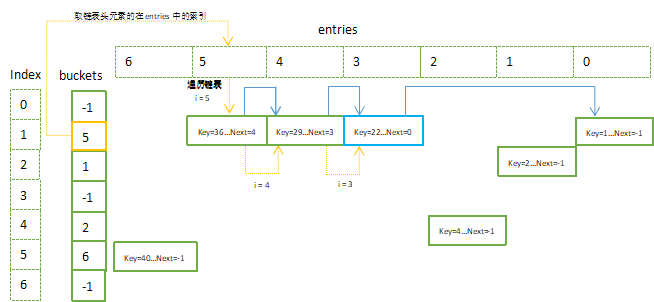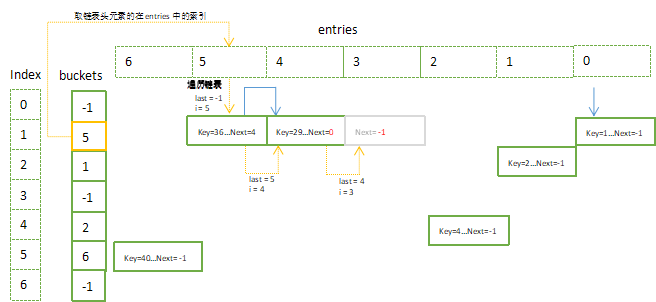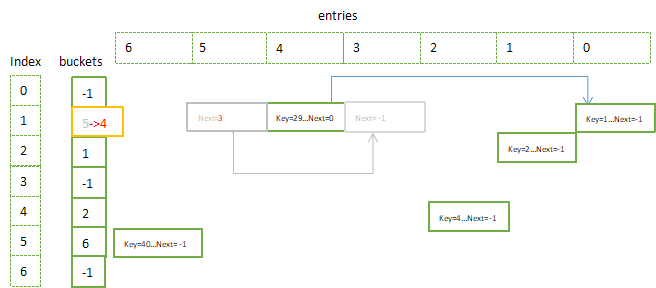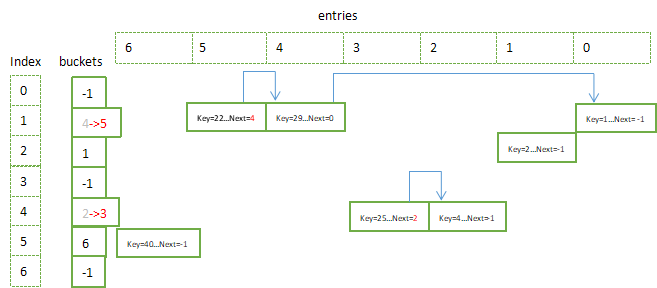目录
- 关键的字段和Entry结构
- 添加键值(Add)
- 取键值(Find)
- 移除键值(Remove)
- 再插入键值
本文是对c#中Dictionary内部实现原理进行简单的剖析。如有表述错误,欢迎指正。
主要对照源码来解析,目前对照源码的版本是.Net Framwork 4.8,源码地址。
1. 关键的字段和Entry结构
struct Entry { public int hashCode; // key的hashCode & 0x7FFFFFFF public int next; // 指向链表下一个元素的地址(实际就是entries的索引),最后一个元素为-1 public TKey key; public TValue value; } Entry[] entries; //存放键值 int[] buckets; //存储entries最新元素的索引,其存储位置由取模结果决定。例:假设键值存储在entries的第1元素的位置上,且hashCode和长度的取模结果为2,那么buckets[2] = 1 int count = 0; //已存储键值的个数 int version; //记录版本,防止迭代过程中集合被更改 IEqualityComparer<TKey> _comparer; int freeList; //entries中最新空元素的索引 int freeCount; //entries中空元素的个数
2. 添加键值(Add)
public void Add(TKey key, TValue value) { Insert(key, value, true); } private void Insert(TKey key, TValue value, bool add) { if( key == null ) { ThrowHelper.ThrowArgumentNullException(ExceptionArgument.key); } if (buckets == null) Initialize(0); int hashCode = comparer.GetHashCode(key) & 0x7FFFFFFF; //取模 int targetBucket = hashCode % buckets.Length; #if FEATURE_RANDOMIZED_STRING_HASHING int collisionCount = 0; #endif for (int i = buckets[targetBucket]; i >= 0; i = entries[i].next) { if (entries[i].hashCode == hashCode && comparer.Equals(entries[i].key, key)) { if (add) { ThrowHelper.ThrowArgumentException(ExceptionResource.Argument_AddingDuplicate); } //对于已存在的Key重新赋值 entries[i].value = value; version++; return; } #if FEATURE_RANDOMIZED_STRING_HASHING collisionCount++; #endif } int index; if (freeCount > 0) { //存在entries中存在空元素 index = freeList; freeList = entries[index].next; freeCount--; } else { if (count == entries.Length) { //扩容:取大于count * 2的最小素数作为entries和bucket的新容量(即数组长度.Length) Resize(); targetBucket = hashCode % buckets.Length; } index = count; count++; } entries[index].hashCode = hashCode; entries[index].next = buckets[targetBucket]; entries[index].key = key; entries[index].value = value; //存取链表的头元素的索引(即entries最后存入的元素的在enties中的索引) //便于取Key的时每次从链表的头元素开始遍历,详细见FindEntry(TKey key)函数 buckets[targetBucket] = index; version++; #if FEATURE_RANDOMIZED_STRING_HASHING #if FEATURE_CORECLR // In case we hit the collision threshold we'll need to switch to the comparer which is using randomized string hashing // in this case will be EqualityComparer<string>.Default. // Note, randomized string hashing is turned on by default on coreclr so EqualityComparer<string>.Default will // be using randomized string hashing if (collisionCount > HashHelpers.HashCollisionThreshold && comparer == NonRandomizedStringEqualityComparer.Default) { comparer = (IEqualityComparer<TKey>) EqualityComparer<string>.Default; Resize(entries.Length, true); } #else if(collisionCount > HashHelpers.HashCollisionThreshold && HashHelpers.IsWellKnownEqualityComparer(comparer)) { //如果碰撞次数(单链表长度)大于设置的最大碰撞阈值,需要扩容 comparer = (IEqualityComparer<TKey>) HashHelpers.GetRandomizedEqualityComparer(comparer); Resize(entries.Length, true); } #endif // FEATURE_CORECLR #endif } ****************************************************************************************************************************************** static void Foo() { var dicData = new Dictionary<int, int>(); //添加键值 new List<int> { 1, 2, 4 }.ForEach(item => Add(item, dicData)); new List<int> { 22, 29, 36, 20 }.ForEach(item => Add(item, dicData)); } static void Add(int key, Dictionary<int, int> dicData) { dicData.Add(key, key); }
2.1 数组entries和buckets初始化
private void Initialize(int capacity) { //取大于capacity的最小质数(素数) int size = HashHelpers.GetPrime(capacity); buckets = new int[size]; for (int i = 0; i < buckets.Length; i++) buckets[i] = -1; entries = new Entry[size]; freeList = -1; } **************************************************** internal static class HashHelpers { ...... public const int HashCollisionThreshold = 100; //碰撞阈值 ...... public static readonly int[] primes = { 3, 7, 11, 17, 23, 29, 37, 47, 59, 71, 89, 107, 131, 163, 197, 239, 293, 353, 431, 521, 631, 761, 919, 1103, 1327, 1597, 1931, 2333, 2801, 3371, 4049, 4861, 5839, 7013, 8419, 10103, 12143, 14591, 17519, 21023, 25229, 30293, 36353, 43627, 52361, 62851, 75431, 90523, 108631, 130363, 156437, 187751, 225307, 270371, 324449, 389357, 467237, 560689, 672827, 807403, 968897, 1162687, 1395263, 1674319, 2009191, 2411033, 2893249, 3471899, 4166287, 4999559, 5999471, 7199369}; //质数(素数)组 ...... public static int GetPrime(int min) { if (min < 0) throw new ArgumentException(Environment.GetResourceString("Arg_HTCapacityOverflow")); Contract.EndContractBlock(); //查找primes是否有满足的质数(素数) for (int i = 0; i < primes.Length; i++) { int prime = primes[i]; if (prime >= min) return prime; } //outside of our predefined table. //compute the hard way. //primes没有查找到满足的质数(素数),自行计算 for (int i = (min | 1); i < Int32.MaxValue;i+=2) { if (IsPrime(i) && ((i - 1) % Hashtable.HashPrime != 0)) return i; } return min; } }

2.2 添加键值{1,1},则
hashCode = 1;
targetBucket = hasCode % buckets.Length; //targetBucket = 1
next = buckets[targetBucket]; //next = -1
buckets[targetBucket] = index; //buckets[1] = 0

2.3 添加键值{2,2},则
hashCode = 2;
targetBucket = hasCode % buckets.Length; //targetBucket = 2
next = buckets[targetBucket]; //next = -1
buckets[targetBucket] = index; //buckets[2] = 1

2.4 添加键值{4,4},则
hashCode = 4;
targetBucket = hasCode % buckets.Length; //targetBucket = 1
next = buckets[targetBucket]; //next = 0
buckets[targetBucket] = index; //buckets[1] = 2

接下来将entries数组以单链表的形式呈现(即enteries数组横向);

2.5 在继续添加键值之前,需要扩容操作,因为entries数组长度为3且都已有元素。扩容后需要对buckets和entries每个元素的Next需要重新赋值;
private void Resize() { //扩容的大小:取大于(当前容量*2)的最小素数 //例: Resize(HashHelpers.ExpandPrime(count), false); } private void Resize(int newSize, bool forceNewHashCodes) { Contract.Assert(newSize >= entries.Length); //实例化buckets,并将每个元素置为-1 int[] newBuckets = new int[newSize]; for (int i = 0; i < newBuckets.Length; i++) newBuckets[i] = -1; Entry[] newEntries = new Entry[newSize]; Array.Copy(entries, 0, newEntries, 0, count); //如果是Hash碰撞扩容,使用新HashCode函数重新计算Hash值 if(forceNewHashCodes) { for (int i = 0; i < count; i++) { if(newEntries[i].hashCode != -1) { newEntries[i].hashCode = (comparer.GetHashCode(newEntries[i].key) & 0x7FFFFFFF); } } } //重建单链表 for (int i = 0; i < count; i++) { if (newEntries[i].hashCode >= 0) { //取模重新设置next值和buckets int bucket = newEntries[i].hashCode % newSize; newEntries[i].next = newBuckets[bucket]; newBuckets[bucket] = i; } } buckets = newBuckets; entries = newEntries; } ******************************************************************* internal static class HashHelpers { ...... public static readonly int[] primes = { 3, 7, 11, 17, 23, 29, 37, 47, 59, 71, 89, 107, 131, 163, 197, 239, 293, 353, 431, 521, 631, 761, 919, 1103, 1327, 1597, 1931, 2333, 2801, 3371, 4049, 4861, 5839, 7013, 8419, 10103, 12143, 14591, 17519, 21023, 25229, 30293, 36353, 43627, 52361, 62851, 75431, 90523, 108631, 130363, 156437, 187751, 225307, 270371, 324449, 389357, 467237, 560689, 672827, 807403, 968897, 1162687, 1395263, 1674319, 2009191, 2411033, 2893249, 3471899, 4166287, 4999559, 5999471, 7199369}; //质数(素数)组 ...... // This is the maximum prime smaller than Array.MaxArrayLength public const int MaxPrimeArrayLength = 0x7FEFFFFD; //数组最大长度的最小质数 public static int ExpandPrime(int oldSize) { //翻倍 int newSize = 2 * oldSize; // Allow the hashtables to grow to maximum possible size (~2G elements) before encoutering capacity overflow. // Note that this check works even when _items.Length overflowed thanks to the (uint) cast //翻倍的大小不能超过【数组最大长度的最小质数】 if ((uint)newSize > MaxPrimeArrayLength && MaxPrimeArrayLength > oldSize) { Contract.Assert( MaxPrimeArrayLength == GetPrime(MaxPrimeArrayLength), "Invalid MaxPrimeArrayLength"); return MaxPrimeArrayLength; } //取最小的质数(素数) return GetPrime(newSize); } public static int GetPrime(int min) { if (min < 0) throw new ArgumentException(Environment.GetResourceString("Arg_HTCapacityOverflow")); Contract.EndContractBlock(); //查找primes是否有满足的质数(素数) for (int i = 0; i < primes.Length; i++) { int prime = primes[i]; if (prime >= min) return prime; } //outside of our predefined table. //compute the hard way. //primes没有查找到满足的质数(素数),自行计算 for (int i = (min | 1); i < Int32.MaxValue;i+=2) { if (IsPrime(i) && ((i - 1) % Hashtable.HashPrime != 0)) return i; } return min; } }

2.6 继续添加键值{22,22},{29,29},{36,36},{40,40},添加完后其内部存储结果如下

3. 取键值(Find)
public TValue this[TKey key] { get { //取Key对应值在entries的索引 int i = FindEntry(key); if (i >= 0) return entries[i].value; ThrowHelper.ThrowKeyNotFoundException(); return default(TValue); } set { //更新Key对应的值 Insert(key, value, false); } } private int FindEntry(TKey key) { if( key == null) { ThrowHelper.ThrowArgumentNullException(ExceptionArgument.key); } if (buckets != null) { int hashCode = comparer.GetHashCode(key) & 0x7FFFFFFF; //遍历单链表 for (int i = buckets[hashCode % buckets.Length]; i >= 0; i = entries[i].next) { if (entries[i].hashCode == hashCode && comparer.Equals(entries[i].key, key)) return i; } } return -1; } ********************************************************************************************* static void Foo() { ...... //取Key=22 var val =dicData[22];
}
简化取Key对应值的代码
var hashCode =comparer.GetHashCode(key) & 0x7FFFFFFF; // 22 var targetBuget = hashCode % buckets.Length; //取模运算 1 var i = bucket[targetBuget]; //链表头元素的索引 bucket[1] = 5 //遍历单链表 for (; i >= 0; i = entries[i].next) { if (entries[i].hashCode == hashCode && comparer.Equals(entries[i].key, key)) return i; }

4. 移除键值(Remove)
public bool Remove(TKey key) { if(key == null) { ThrowHelper.ThrowArgumentNullException(ExceptionArgument.key); } if (buckets != null) { int hashCode = comparer.GetHashCode(key) & 0x7FFFFFFF; int bucket = hashCode % buckets.Length; int last = -1; //其原理先取出键值,然后记录entries空闲的索引(freeList)和空闲个数(freeCount) for (int i = buckets[bucket]; i >= 0; last = i, i = entries[i].next) { if (entries[i].hashCode == hashCode && comparer.Equals(entries[i].key, key)) { if (last < 0) { buckets[bucket] = entries[i].next; } else { entries[last].next = entries[i].next; } entries[i].hashCode = -1; //建立空闲链表 entries[i].next = freeList; entries[i].key = default(TKey); entries[i].value = default(TValue); //保存entryies中空元素的索引 //便于插入新键值时,放在当前索引的位置,减少entryies空间上的浪费 freeList = i; //空元素的个数加1 freeCount++; version++; return true; } } } return false; } ******************************************************************* static void Foo() { ...... //移除 new List<int> { 22, 29 }.ForEach(item => dicData.Remove(item)); }
4.1 移除Key=22后,freeList = 3, freeCount = 1,

4.2 移除Key=36后,freeList = 5, freeCount = 2,

5. 再插入键值
如上图,当移除掉{36,36}后,会发现又诞生一个含有两个元素的“新链表”(上图灰色框)。这个作用就是为了插入新键值时,按照“新链表”记录的索引顺序插入到entries数组中。
例:添加键值{22,22},{25,25},此时freeList = 5,freeCount = 2;
-
给entries[5]赋值,freeList = 3, freeCount = 1;
- 给entries[3]赋值,freeList = -1, freeCount = 0;

希望此文能够让你对于Dictionary内部实现有所认识。